IN THIS ISSUE
- Wild promise of Ceylon
- What our eagle nest survey found
- Hunting for flying leopards
- An electrofishing boat with a history
- Watch: bog work behind the scenes
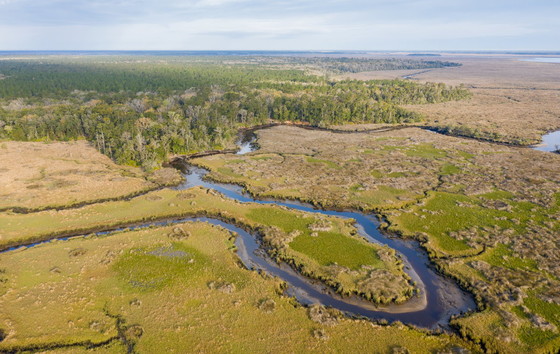 Aerial of Cabin Bluff and Ceylon properties (Mac Stone -- Facebook: @mac stone photography)
By DAN CHAPMAN
Georgia’s newest wildlife management area sits a half mile off Interstate 95, yet a world removed from the hurly-burly of modern life. Pass the entrance on Ceylon Road and you step back in time.
Stands of longleaf pine and live oak, some two centuries old, tower over savannah-like prairies and freshwater wetlands. More than 4,000 gopher tortoise burrows dot the landscape. Artesian wells bubble up from the ground. Vine-covered Ceylon Cemetery stands vigil for communities that once prospered along the banks of the Satilla River.
Yet the importance of Ceylon Wildlife Management Area goes well the beyond the cultural and recreational amenities (including hunting) offered by one of the Eastern seaboard’s largest unprotected tracts. Ceylon and adjoining Cabin Bluff are linchpins in plans to create a conservation corridor along the Georgia coast and into Florida. …
Read about Ceylon’s wonder and promise in this post by Fish and Wildlife Service public affairs specialist Dan Chapman.
Also: conserving 17,000 acres in the Florida Panhandle.
Top
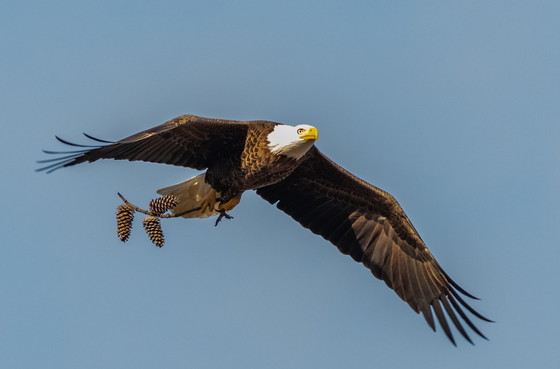 Bald eagle carrying nesting material (Jenny Burdette/Georgia Nature Photographers Association)
While bald eagles posted another strong year for nesting in the state, heavy winter rains likely dampened nest totals in north Georgia, according to DNR’s annual nest survey.
Checking by helicopter in January, March and April, survey leader Dr. Bob Sargent counted 117 eagle nest territories in three regions: the six coastal counties; a section of east Georgia bounded roughly by interstates 16 and 85 and the South Carolina line; and the counties north of Atlanta. Chatham, on the coast, led all counties checked with 23 active nests.
Considering that the rest of south Georgia, which is surveyed every other year, usually has about 85 active nests, the state likely had 200 or more eagle nests for the sixth straight year, Sargent said.
This year an estimated 126 young fledged from 82 nests. The 1.5 fledglings per nest matched the long-term average. But the percentage of successful nests and the number of young fledged per occupied nest territory were both below-average, especially in the northernmost counties.
The possible culprit: significant rainfall – as much as double the 30-year average in some areas – that coincided with north Georgia’s nesting peak for bald eagles. Excessive rain can postpone nesting and cause nest failures.
Looking at the big picture, however, Sargent said “the overall productivity trend for bald eagles nests in Georgia continues to look healthy.”
More on DNR's 2020 eagle nesting survey.
HOW YOU CAN HELP
Top
 Giant leopard moth (Terry W. Johnson)
By TERRY W. JOHNSON
One of Georgia’s most distinctive nighttime insects is the giant leopard moth.
Not only does this insect’s beauty rival that of any of our well-known butterflies, its name is both intriguing and memorable.
Because giant leopard moths are creatures of the night, we rarely see them.
However, now is a good time across the state to find one, or more. …
Enjoy the rest of Terry’s column about the remarkable giant leopard moth.
Terry W. Johnson is a retired DNR program manager and executive director of TERN, the Wildlife Conservation Section’s friends group. Check out past columns, his Backyard Wildlife Connection blog and his book “A Journey of Discovery: Monroe County Outdoors.” (Permission is required to reprint this column.)
Top
 The boat that collected the first robust redhorse in 1991 is still in use (Brett Albanese/DNR)
By PETER DIMMICK, PAULA MARCINEK and DEB WEILER
Studying fish and other aquatic species is often difficult, especially if the species you’re searching for is rare and access to its habitat is limited. Sampling in aquatic environments also almost always requires specialized equipment, and even more so when the target lives in waters that require using a boat.
The threatened robust redhorse sucker is a prime example. In 1991, while conducting standard game-fish surveys with a modified boat in the Oconee River downstream of Sinclair Dam, DNR fisheries biologists collected an unusual sucker. It turned out to be a robust redhorse, a species that had been considered extinct.
This rediscovery sparked efforts to conserve the fish that continue today.
Interestingly, the small electrofishing boat used to collect that first robust redhorse 29 years ago is still in use. At least as interesting is how electrofishing works. ...
Read about electrofishing and the jon boat that could in this blog post.
Top
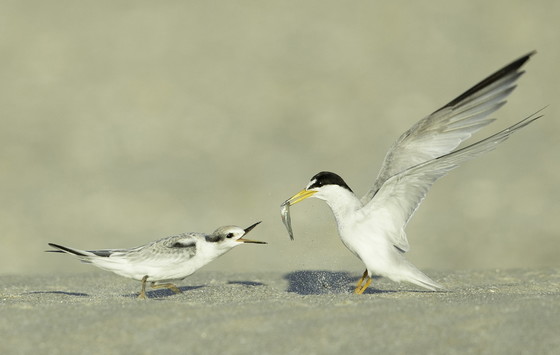 Least tern feeding a chick on St. Simons (Ty Ivey/Georgia Nature Photographers Association)
Headed to the beach this summer? Give shorebirds and seabirds the space they need to raise young and forage for food by following these tips:
- Avoid posted sites. (Eggs and chicks are camouflaged and easy to overlook or even step on. For example, watch this video from St. Simons Island.)
- Walk below the high-tide line.
- Watch beach birds only from a distance.
- Back away from any nesting birds you accidentally disturb.
- Leave dogs at home, or if on a beach that allows them, keep them on a leash.
Planning to camp in the mountains? Check out these BearWise precautions for avoiding black bears, plus what to do if you encounter one. (Also available: flyers, books and activities for children).
Over the last 10 years, more than 1.3 million acres of longleaf pine stands have been established and nearly 12 million acres of longleaf habitat treated with prescribed fire. For these and other updates, see the America’s Longleaf Restoration Initiative 2019 report, which also marks the initiative’s 10th anniversary.
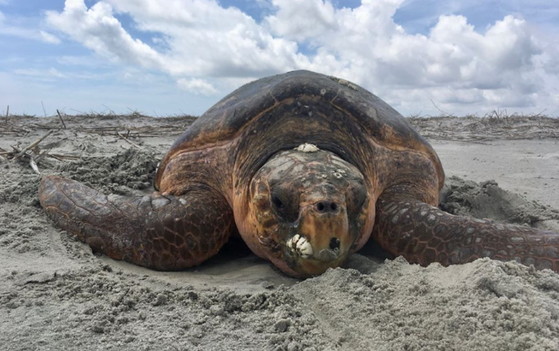 Nesting loggerhead (Mark Dodd/DNR)
Georgia’s nest count for loggerhead sea turtles topped 1,170 as of Monday (updates). Through late May, loggerheads were nesting at the second-highest rate in the past nine years, exceeded only by last summer, when the state’s primary marine turtle set a modern-day record of 3,950 nests. (Check out this loggerhead, which although missing part of a flipper from a boat collision still managed to nest.)
If you missed Southeastern Partners in Plant Conservation 2020 in March, you can still benefit from the discussions varying from culturally significant plants to conserving rare plants on private lands. The presentations are posted here.
Farmers interested or involved in U.S. Agriculture Department conservation programs can find details and tools to manage their activities online.
Newly published research that gauges the threat predators pose to sea turtle eggs on Georgia’s coast includes DNR senior wildlife biologist Mark Dodd as a contributor. Led by Zachary Butler of UGA’s Odum School of Ecology, the study in Global Ecology and Conservation found that feral hogs and raccoons are the top predators of sea turtle eggs, that losses to all predators are similar to those caused by tides and storms, and that non-native predators – primarily hogs – cause significantly more loss than natives such as raccoons and ghost crabs. Dr. Wendy B. Zomlefer, who retired from UGA in 2019, has received the Southern Appalachian Botanical Society’s highest honor for an individual, the Elizabeth Ann Bartholomew Award. The society noted that Zomlefer’s “service to the state and region through her role as curator of the University of Georgia Herbarium is inspirational and seems to parallel that of Betty Bartholomew.”
WHAT YOU MISSED ...
In the previous Georgia Wild:
- Lost plant found
- Nesting barn swallows
- Secret snakes: rainbows and muds
- New teachers guide explores sandhills
Top
"Decline in eagles' birth rate likely due to heavy rain," SaportaReport. Also: The (Gainesville) Times, Rome News-Tribune, Savannah Morning News (paywall).
"Cameras reveal possible uptick in urban wildlife," UGA
"Give beach-nesting birds their space," Coastal Courier
"Migration numbers plunge for threatened red knots," The New York Times (paywall)
"Majority of ships ignoring voluntary slowdown for right whales," Canadian Broadcasting Corp.
"New teacher guide highlights Georgia sandhill habitat," Rockdale Newton Citizen
"Bird-watching soars amid COVID-19," The Associated Press
"#BlackWomenWhoBird: a personal reflection," U.S. Fish and Wildlife Service
"Sea turtle nests at second-highest level in nine years," SaportaReport
"How rebel botanists use graffiti to name forgotten flora," The Guardian
"Biologist shares experience with now extinct Bachman’s warbler," Savannah Morning News
"More opportunities proposed to hunt, fish," U.S. Fish and Wildlife Service
Top
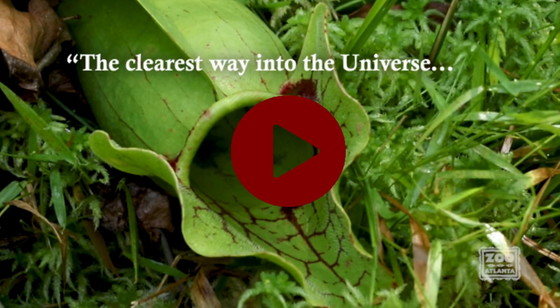 "Horticulture conservation: mountain bogs," Zoo Atlanta profiles work by Georgia Plant Conservation Alliance members to conserve a northeast Georgia mountain bog
"Osprey chick opens wings wide in Savannah," Landings Bird Cam
"Social distancing at parks," DNR State Parks and Historic Sites. Also: Spanish moss.
"Georgia's Angler Awards Program," DNR Wildlife Resources Division
Top
 Steelhead trout by Kelly Zhong, first in nation in contest's Fish Migration category
The leading entries in the 2020 Georgia Fish Art Contest are eye-catching. Included is this national award-winning steelhead trout by a Georgia fourth-grader. Take a look at the top picks for the state and national contest sponsored by DNR, Wildlife Forever and Bass Pro Shops.
CREDITS
Masthead: bald eagle pair in Floyd County (Tom Wilson/Georgia Nature Photographers Association)
Top
|